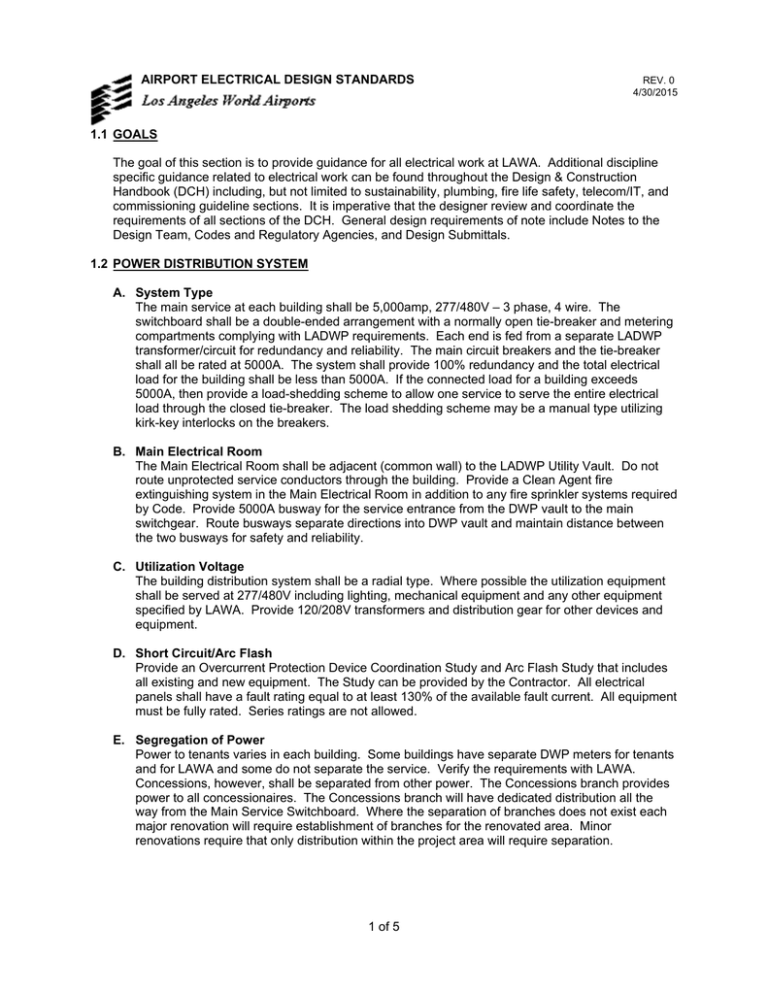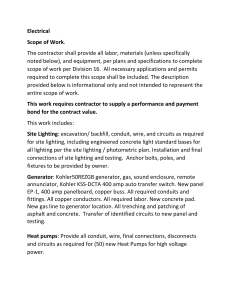Electrical Design Standards
advertisement

AIRPORT ELECTRICAL DESIGN STANDARDS REV. 0 4/30/2015 1.1 GOALS The goal of this section is to provide guidance for all electrical work at LAWA. Additional discipline specific guidance related to electrical work can be found throughout the Design & Construction Handbook (DCH) including, but not limited to sustainability, plumbing, fire life safety, telecom/IT, and commissioning guideline sections. It is imperative that the designer review and coordinate the requirements of all sections of the DCH. General design requirements of note include Notes to the Design Team, Codes and Regulatory Agencies, and Design Submittals. 1.2 POWER DISTRIBUTION SYSTEM A. System Type The main service at each building shall be 5,000amp, 277/480V – 3 phase, 4 wire. The switchboard shall be a double-ended arrangement with a normally open tie-breaker and metering compartments complying with LADWP requirements. Each end is fed from a separate LADWP transformer/circuit for redundancy and reliability. The main circuit breakers and the tie-breaker shall all be rated at 5000A. The system shall provide 100% redundancy and the total electrical load for the building shall be less than 5000A. If the connected load for a building exceeds 5000A, then provide a load-shedding scheme to allow one service to serve the entire electrical load through the closed tie-breaker. The load shedding scheme may be a manual type utilizing kirk-key interlocks on the breakers. B. Main Electrical Room The Main Electrical Room shall be adjacent (common wall) to the LADWP Utility Vault. Do not route unprotected service conductors through the building. Provide a Clean Agent fire extinguishing system in the Main Electrical Room in addition to any fire sprinkler systems required by Code. Provide 5000A busway for the service entrance from the DWP vault to the main switchgear. Route busways separate directions into DWP vault and maintain distance between the two busways for safety and reliability. C. Utilization Voltage The building distribution system shall be a radial type. Where possible the utilization equipment shall be served at 277/480V including lighting, mechanical equipment and any other equipment specified by LAWA. Provide 120/208V transformers and distribution gear for other devices and equipment. D. Short Circuit/Arc Flash Provide an Overcurrent Protection Device Coordination Study and Arc Flash Study that includes all existing and new equipment. The Study can be provided by the Contractor. All electrical panels shall have a fault rating equal to at least 130% of the available fault current. All equipment must be fully rated. Series ratings are not allowed. E. Segregation of Power Power to tenants varies in each building. Some buildings have separate DWP meters for tenants and for LAWA and some do not separate the service. Verify the requirements with LAWA. Concessions, however, shall be separated from other power. The Concessions branch provides power to all concessionaires. The Concessions branch will have dedicated distribution all the way from the Main Service Switchboard. Where the separation of branches does not exist each major renovation will require establishment of branches for the renovated area. Minor renovations require that only distribution within the project area will require separation. 1 of 5 AIRPORT ELECTRICAL DESIGN STANDARDS REV. 0 4/30/2015 F. Equipment Rooms All electrical distribution equipment shall be located in dedicated electrical rooms. Rooms shall be dedicated solely to electrical equipment. Each room, regardless of size, shall have exposed grounding bars installed along walls for ease of equipment grounding. Provide additional space in all rooms to allow the addition of one future section for all switchboards. Provide the additional space so the future section can be added to either side of the switchboards. Designate all conduit entry points and routing paths within the equipment rooms to verify that future loads can be served from the panels in the rooms. Switchgear, switchboards, panelboards and motor control centers shall have adequate vertical wireways to serve spares circuit breakers or spaces for future circuit breakers. G. Emergency Power Only equipment related to fire/life-safety shall be connected to the emergency power distribution system. Review telecom/IT design guidelines for emergency power requirements; any variances to be approved by LAWA. Other tenant related loads that are not fire/life-safety shall be supplied by a tenant provided emergency power source. Any tenant provided systems shall utilize batteries as a source. Concessions spaces and Passenger Boarding Bridges may utilize battery units for all required emergency power sources including any life-safety/egress lighting. The emergency power system shall be fed from an on-site diesel driven emergency generator set through automatic transfer switch(es). The generators must comply with the Tier 4 Level emissions requirements. The Tier Level requirement can be reduced to the Tier Level in effect in force at the time of the project as required by SCAQMD. Generators must utilize sub-base fuel oil tanks. Underground or separate above ground tanks are not allowed. 1.3 EQUIPMENT A. General 1. Manufacturers: For standardization purposes all panelboards, switchboards, switchgear, and transformers shall be limited to General Electric, Square D and Eaton. 2. Seismic Criteria: All equipment, major components and anchorage must be certified to meet all seismic requirements of the Code. 3. Certification: All equipment must have LARR numbers where applicable 4. LAWA requires a unique system of identification for all conduits, feeders, wiring, enclosures, devices, panels and equipment. Refer to Guide Specifications for complete details. B. Main Switchgear Main switchgear (gear fed directly from DWP transformers) shall be metal-enclosed switchgear utilizing insulated case draw-out type circuit breakers for long-term maintenance and reliability. Provide breakers with metering capability compatible with the electrical submetering system. Provide sufficient switchgear sections to allow enough conduit entry space to accommodate all feeders including feeders for future sections. C. Distribution Switchboards/Panelboards Panels rated greater than 800A shall be switchboards. Panels 800A or less shall be distribution panelboards. All boards shall utilize full-length copper bussing with full-size neutrals. Circuit breakers may be group mounted molded case circuit breakers. Fused switch assemblies are not allowed. Circuit breakers in switchboards shall be electronic trip type breakers. Provide 20% spare fully bussed space in all boards. All boards shall be fully rated for 130% of the available short circuit fault current. All devices must be fully rated. Series-rating of breakers is not allowed. Provide sufficient sections to allow enough conduit entry space to accommodate all feeders including feeders for future sections. 2 of 5 AIRPORT ELECTRICAL DESIGN STANDARDS REV. 0 4/30/2015 D. Raceways and Enclosures: a. Definitions: 1) Outdoor Locations: Locations directly exposed to weather. 2) Wet Locations: Locations subject to saturation with water or in direct contact with concrete, masonry or earth. 3) Damp Locations: i) Locations protected from weather, not subject to saturation with water. In covered locations with open sides that are subject to wind-driven rain, areas directly under roof or protected with a soffit/header will be considered damp. ii) In a building with partially open sides, areas below the soffit/header line and within 10’ of an opening are considered damp locations. 4) Dry Locations: i) Locations not normally subject to dampness or wetness. ii) In a building with partially open sides, areas above the soffit/header line are considered dry locations. b. Raceways: 1) Outdoor Locations: Use Galvanized Rigid Steel. 2) Wet and Damp Locations: Use Galvanized Rigid Steel. 3) Dry Locations: Zinc Plated EMT or Galvanized Rigid Steel is allowed in all locations. 4) Where Subject to Physical Damage: Use Galvanized Rigid Steel 5) Tug Routes, bag tug areas and other drive aisles: i) Above the tallest vehicle, tug, cart, trailer, etc, use Zinc Plated EMT, unless area is defined as Damp or Wet. ii) Below the tallest vehicle, tug, cart, trailer, etc, use Galvanized Rigid Steel. 6) Type MC Cable, Romex, or aluminum conduits are not allowed. 7) Flexible Conduits: Use flexible steel conduits for termination to equipment. c. Enclosures at LAX: Due to highly corrosive nature at LAX, for all outdoor electrical enclosures, including switchboards / panelboards, use NEMA Type 4 or NEMA Type 3R stainless steel gasketed enclosures. See Specification Section 26 05 02 for additional information. 1.4 METERING A. Utility (DWP) metering varies in each building. Confirm the metering arrangement with LAWA. B. Submetering utilizing a web-based Power Monitoring Communication System is required for all loads. These submetered loads include, but are not limited to, the following: 1. Concessions: Provide a separate submeter for each concession space. 2. TSA Rooms and Equipment 3. In-Line Baggage System 4. Passenger Boarding Bridges: Pre-conditioned air, 400Hz units and bridges. Provide separate submeter for each boarding bridge and associated pre-con air and 400Hz unit. 5. Airline VIP Lounges 6. Major Refrigeration Units 7. Any major electrical load not covered by the lease agreement. C. The submetering system must be compatible with an Eaton web-based power monitoring communications system. Consolidate meters as much as possible in multi-meter enclosures within electrical rooms. Utilize circuit breakers with built-in metering where possible. Network all meters together using appropriate copper/fiber wiring and appropriate gateways and routers. 3 of 5 AIRPORT ELECTRICAL DESIGN STANDARDS REV. 0 4/30/2015 D. The metering system can also be used for compliance with Title 24 Energy Code including disaggregation of circuits. All panels and meters shall be clearly identified with the metering arrangement and bus structure. 1.5 LIGHTING A. General Lighting fixtures and design shall provide the lighting levels, visual comfort, color rendering and aesthetics to complement the area where it is installed. Lighting of public areas is especially important to LAWA and all lighting design in public areas shall be approved by LAWA prior to submitting documents for plan check. All lighting shall be installed in areas accessible by ladder or lift for ease of maintenance. B. Lamp Sources All lighting design shall be as energy efficient as possible and shall comply with the latest Title 24 requirements. Where appropriate, LAWA encourages the use of LED lamp sources utilizing the appropriate color temperatures; provide consistent color temperature (tight binning), high CRI (85+), and rated life>50,000 hours. Otherwise, utilize fluorescent (lamps shall be T8) and where necessary provide HID sources. C. Lighting Controls Provide a complete programmable system allowing for daylight harvesting, DMX-512 fixture control, and interfacing with Building Automation Control system in accordance with Title 24 guidelines. Provide distributed or centralized relay network control utilizing Cat 5 network cabling, routers, bridges, control devices and fixtures for a fully addressable control system. The lighting control system shall be programmable for individual fixtures or zones and shall annunciate at the building engineer’s office and at LAX, the Central Utility Plant. D. Lighting Levels 1. Interior - The following lighting levels are recommended for building public areas. Other areas should conform with Title 24, IES standards and industry standards. a. Arrival (Exterior) = 5-10FC b. Artwork and Displays = 40-50FC c. Back of House Areas 1) General illumination for working areas = 25-35FC 2) Corridors and stairways = 5-10FC d. Baggage Handling = 35-45FC e. Concessions and Food Courts 1) General illumination = 15-20FC 2) Work surfaces = 35-45FC f. Concourse = 10-15FC g. Departure (Exterior) = 5-10FC h. Information Desks = 30-40FC i. Restrooms = 10-15FC j. Retail 1) General illumination = 20-25FC 2) Accenting = 40-50FC k. TSA / Security 1) General illumination = Per current TSA guideline l. Ticketing 1) General illumination = 15-20FC 2) Work Surfaces = 35-45FC 2. Exterior - Apron Lighting Levels: 4 of 5 AIRPORT ELECTRICAL DESIGN STANDARDS REV. 0 4/30/2015 a. Minimum horizontal illuminance at ground level: 2.0 foot-candles at 200 feet. b. Maximum horizontal illuminance at ground level: 0.5 foot-candles at 300 feet. c. Minimum vertical illuminance at a height of 3 feet above ground level: 5.0 foot-candles at a distance of 200 feet. d. Maximum vertical illuminance at a height of 50 feet: 0.25 foot-candles at 250 feet. e. Fixture Type: Gardco Aktra II floodlight with internal reflector to reduce glare and block high angle light. Mount fixture on lowering device with ballasts installed within fixture. For non-lowering devices provide remote ballast at base of pole. Round, tapered steel poles. For two-piece poles; minimum 3 gauge for lower section and 7 gauge for upper section. 3. Building Exteriors and Parking - Provide fuses and fuse holders for outdoor lighting ballasts and light pole fixtures. For exterior wallpacks use induction type lamps. 1.6 RENOVATION / REMODEL WORK A. Generally, all equipment and devices within the limits of the renovation must be completely removed. All wiring must be removed back to the last active device even if it resides outside the limits of the remodel/demolition. For branch wiring this is to the last receptacle, switch or other device remaining in service. If the wiring is a feeder serving only the removed equipment then the feeder must be removed all the way back to the serving electrical panel regardless of the serving panel location. All conduits within the limits of the remodel must be removed. Conduits can be cut off at the limits of the renovation and the conduit outside the limits of remodel can be abandoned in place and identified as ”abandoned”. B. If new conduit runs are placed on existing conduit racks then the existing racks within the remodel area must be modified to meet current Codes and Standards. If conduit runs that pass through the remodel area are to remain then those racks within the remodel area must be modified to meet current Codes and Standards. Reuse of an existing conduit requires that the entire conduit run be modified to meet current Codes and Standards including those portions outside the remodel area. C. Power Shutdown: Refer to the LAWA Power Shutdown Requirements. 5 of 5


